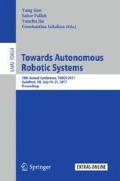Abstract
Through simulation, this paper evaluates the capabilities of the EcoSUB\(\mu \), a small, low cost Autonomous Underwater Vehicle (AUV), to perform emergent and adaptive behaviours for environmental monitoring. It is assumed in realistic environments the vehicles cannot communicate simultaneously, leading to the development of a communication overhead. The limitations of an optical modem are found to be too extensive to conduct a flocking behaviour while an acoustic modem of increased range allows the EcoSUB\(\mu \) to perform the flocking behaviour and locate a maxima, simulating tracking a chemical plume. The performance of large swarms degrades due to the communication overhead, whereas the performance of smaller swarms is comparable to an individual vehicle. The results highlight the heavy reliance of an emergent behaviour on communication and how the limitations of underwater communication mean this behaviour is unlikely to be suitable for the control of an AUV swarm in realistic ocean environments.
Access this chapter
Tax calculation will be finalised at checkout
Purchases are for personal use only
Notes
- 1.
The EcoSUB\(\mu \) development is funded by the Innovate UK project ‘Launch & Recovery of Multiple AUVs from an USV’, Innovate UK Project Ref 102302 http://gtr.rcuk.ac.uk/projects?ref=102302 aiming to reduce the dependency of marine science on expensive research ships.
References
Amory, A., Tosik, T., Maehle, E.: A load balancing behaviour for underwater robot swarms to increase mission time and fault tolerance. In: IEEE 28th International Parallel and Distributed Processing Symposium Workshops (2014)
Couzin, I., et al.: Collective memory and spatial sorting in animal groups. J. Theor. Biol. 218, 1–11 (2002)
Dorigo, M., Şahin, E.: Swarm robotics - a special issue editorial. Auton. Robot. 17(2–3), 111–113 (2004)
Kottege, N., Zimmer, U.R.: Underwater acoustic localization for small submersibles. J. Field Robot. 28(1), 40–69 (2010)
Liu, J., Zhaohui, W., Peng, Z., Cui, J., Fiondella, L.: Suave: swarm underwater autonomous vehicle localisation. In: Proceedings of IEEE, INFOCOM, 2014 (2014)
Osterloh, C., Meyer, B., Amory, A., Pionteck, T., Maehle, E.: MONSUN II - towards autonomous underwater swarms for environmental monitoring. In: IROS 2012 - Workshop on Robotics for Environmental Monitoring (2012)
Read, M., Möslinger, C., Dipper, T., Kengyel, D., Hilder, J., Thenius, R., Tyrrell, A., Timmis, J., Schmickl, T.: Profiling underwater swarm robotic shoaling performance using simulation. In: Natraj, A., Cameron, S., Melhuish, C., Witkowski, M. (eds.) TAROS 2013. LNCS (LNAI), vol. 8069, pp. 404–416. Springer, Heidelberg (2014). doi:10.1007/978-3-662-43645-5_42
Reynolds, C.: Flocks, herds and schools: a distributed behavioral model. In: ACM SIGGRAPH Computer Graphics (1987)
Schill, F., Zimmer, U.R.: A scalable electro-magnetic communication system for underwater swarms. In: IFAC Proceedings of Manoeuvring and Control of Marine Craft (2012)
Schill, F., Bahr, A., Martinoli, A.: Vertex: a new distributed underwater robotics platform for environmental monitoring. In: Proceedings of the 13th International Symposium on Distributed Autonomous Robotic Systems (2016)
Tan, Y., Chitre, M., Hover, F.: Cooperative Bathymetry-based localization using low-cost autonomous underwater vehicles. Auton. Robot. 40(7), 1187–1205 (2016)
Walls, J.M., Eustice, R.M.: An origin state method for communication constrained cooperative localization with robustness to packet loss. Int. J. Robot. Res. 33(9), 1191–1208 (2014)
Hydromea: LUMA 250LP data sheet. http://hydromea.com/datasheets/Hydromea/LUMA/250/datasheet.pdf. Accessed 30 Jan 2017
Planet Ocean Ltd.: New Micro Autonomous Vehicles Launched by Planet Ocean. http://planet-ocean.co.uk/PDF/ecoSUB.pdf. Accessed 12 Feb 2017
Author information
Authors and Affiliations
Corresponding author
Editor information
Editors and Affiliations
Rights and permissions
Copyright information
© 2017 Springer International Publishing AG
About this paper
Cite this paper
Lowndes, T.S., Phillips, A.B., Harris, C.A., Rogers, E., Chu, B., Popova, E. (2017). Evaluating the Capabilities of a Flight-Style Swarm AUV to Perform Emergent and Adaptive Behaviours. In: Gao, Y., Fallah, S., Jin, Y., Lekakou, C. (eds) Towards Autonomous Robotic Systems. TAROS 2017. Lecture Notes in Computer Science(), vol 10454. Springer, Cham. https://doi.org/10.1007/978-3-319-64107-2_19
Download citation
DOI: https://doi.org/10.1007/978-3-319-64107-2_19
Published:
Publisher Name: Springer, Cham
Print ISBN: 978-3-319-64106-5
Online ISBN: 978-3-319-64107-2
eBook Packages: Computer ScienceComputer Science (R0)

